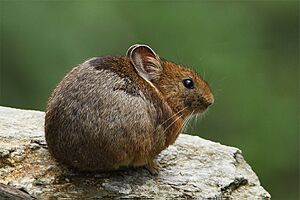Royle's pika facts for kids
Quick facts for kids Royle's pika |
|
|---|---|
 |
|
| Conservation status | |
| Scientific classification | |
| Genus: |
Ochotona
|
| Species: |
roylei
|
| Subspecies | |
|
|
| Synonyms | |
|
|
Royle's pika, also called the Himalayan mouse hare, is a small, furry animal. It belongs to the pika family. You can find this pika in several countries. These include Bhutan, China, India, Nepal, and Pakistan.
Contents
What Royle's Pika Looks Like
Royle's pika is a common pika in the Himalayas. It grows to be about 17 to 22 centimeters long. That's roughly the length of a standard pencil.
This pika has a head that looks slightly rounded. Its body is a mix of reddish-grey colors. The top of its head is a chestnut brown. It also has a bit of thin hair in front of its ears.
Where Royle's Pika Lives
This pika species is very common in the Himalayas. Sometimes, people might confuse it with the large-eared pika. Both species live in the same areas.
You can often spot these pikas in open, rocky mountain places. They also live on slopes. Sometimes, they are found in forests with conifer trees. These trees include pine, deodar, and rhododendron.
Daily Habits of Royle's Pika
Royle's pikas are most active during dawn and dusk. This means they look for food early in the morning and late in the evening. They tend to rest during the middle of the day. This helps them avoid getting too hot when temperatures rise.
During the monsoon season, they are more active. This is because there is more food available for them. Royle's pikas have even been seen living close to human homes.
Royle's Pika Homes
Royle's pikas do not build their own nests. Instead, they use small, narrow cracks in rocks. They also use burrows that other animals have already made. They fill these spots with hay and pine leaves to make them cozy.
They also use the rocky parts of the mountains to stay safe. These rocky areas help them hide from animals that might try to hunt them.
Protecting Royle's Pika
The Royle's pika is listed as "Least Concern" by the IUCN Red List. This means they are not currently in great danger of disappearing.
However, they still face some challenges. Their homes are sometimes lost because of human activity. More people are building homes in hilly areas. This can indirectly affect the pikas and their living spaces.


